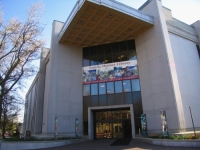Culture
Music
Music and hymns have been an integral part of our culture since its very inception. We believe that singing is an important form of worship and prayer to God. ()The Tabernacle Choir

Music and the Spoken Word, a radio program that features the choir, is the longest running continuous network broadcast in history (75 years and counting) and is played on more than 2,000 radio and television stations.
Hymns
The hymnbook used by the Church in its regular meetings is available online. The online version includes aids to help listeners learn the words and parts to each song. The modern hymnbook was first published in 1985 and contains 341 hymns, 26 of which were included in the original hymnal compiled by Emma Smith in 1836.
Contemporary Church Music
Contemporary music includes hymn arrangements, orchestral works, and our version of “Christian rock.” Popular artists include Michael McLean, Kenneth Cope, Hilary Weeks, Jericho Road, Julie de Azevedo, Afterglow, and Enoch Train.
Cinema

Examples of church-related cinema (i.e. movies with Mormon-culture themes) include American Mormon, Baptists At Our Barbecue, Book of Mormon Movie, Brigham City, Down and Derby, God’s Army, Jack Weyland’s Charly, Johnny Lingo, Legacy, Mobsters and Mormons, The Singles Ward, Mr. Krueger’s Christmas, Pride & Prejudice, Saints and Soldiers, Saturday’s Warrior, Sons of Provo, The Best Two Years, The Book of Mormon Movie, The Home Teachers, The Legend of Johnny Lingo, The Other Side of Heaven, The R.M., and The Work and the Glory: American Zion. Detailed descriptions of these movies can be found at www.ldsvideo.com.
Education

The Church has an extensive secular-education program as well, including universities in the United States and elementary and secondary schools abroad. Over 50,000 full-time day students are enrolled in Church university, elementary, or secondary schools. BYU Provo, with 30,000 students, is the largest single-campus private university in the United States (and probably the world). (Accurate as of ~2004.)

(Accurate as of 2006.)
Fifty languages are taught in the LDS Missionary Training Center (MTC) in Provo, Utah.
(Accurate as of 2003.)
In 2001, the Church established what it calls the “Perpetual Education Fund.” Low-rate college loans are made to impoverished students in the developing world, students that could not otherwise obtain a good education. Over 10,000 loans have been made to date, and the project is expanding.
(Accurate as of 2006.)
As member of our church become more educated they are more likely to be active Church participants, a trend opposite that found in most denominations.
(Accurate as of 1995?)
Utah was ranked first in the nation in both AP exams taken and exams passed per capita.
(Accurate as of 1997.)
“Utah is 50th in spending per pupil, but first in adults that graduated from high school and attended college.”
(Accurate as of 2006.)
The Importance of the Family
Families are central to our culture. We believe that marriages can last forever, not just until death. These kind of eternal marriages are called sealings. ()
Statistically, of all the United States, Utah is…
- First in children with two parents.
- First in birth rate and family size.
- First in number of married couples.
(Accurate as of 2006, 1999?.)
LDS Couples that marry in Temples have the lowest divorce rate “among all U.S. social and religious groups studied.” The divorce rate is 5.4% for men and 6.5% for women. Click to take a virtual tour of Temple Square, where I was married!
(Accurate as of 1999?, 1996.)
Of course, statistics do not fully capture the cultural importance we assign to the family. A personal essay I wrote while serving a mission in Brazil, entitled
The Chain, may help illustrate this principle better than mere numbers.

The LDS Family History Library in Salt Lake City, Utah.
We are also very interested in our family history. The LDS Church has established the world’s largest genealogical database. It can be accessed on-line (www.familysearch.org) or through over 3,700 free branch libraries, all staffed by volunteers that help visitors learn to use family-history software and equipment. The Church has also created a computer program called “Personal Ancestral File” that allows everyone, whether a member of our church or not, to organize their own family history.

An LDS Family History Center.
Why the emphasis on family history? Remembering those who have gone before is central to our culture. Malachi 4:5-6 teaches, “Behold, I will send you Elijah the prophet before the coming of the great and dreadful day of the LORD: And he shall turn the heart of the fathers to the children, and the heart of the children to their fathers, lest I come and smite the earth with as curse.” We believe this “turning of the hearts” is family history work and the subsequent work done in temples
that unite families across generations. Thus the emphasis on family history is an outgrowth of our emphasis on the family. (Accurate as of 2006.)
One Response to “The Culture of the Church of Jesus Christ of Latter-day Saints”